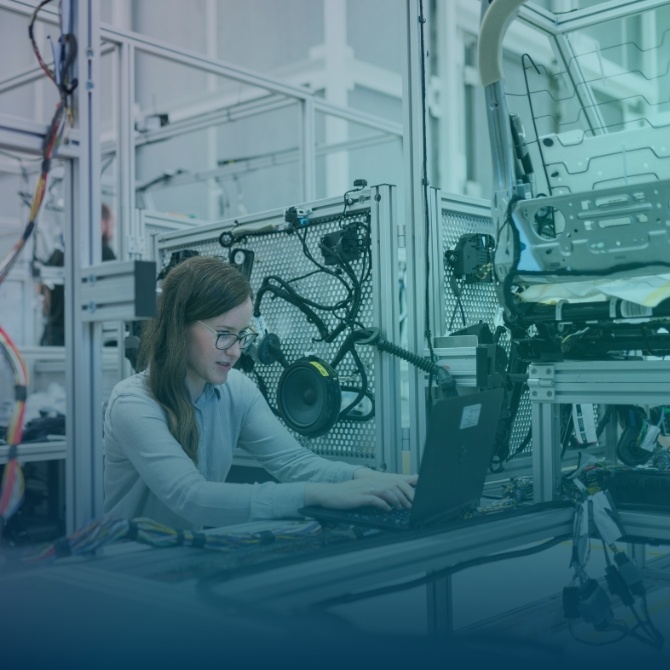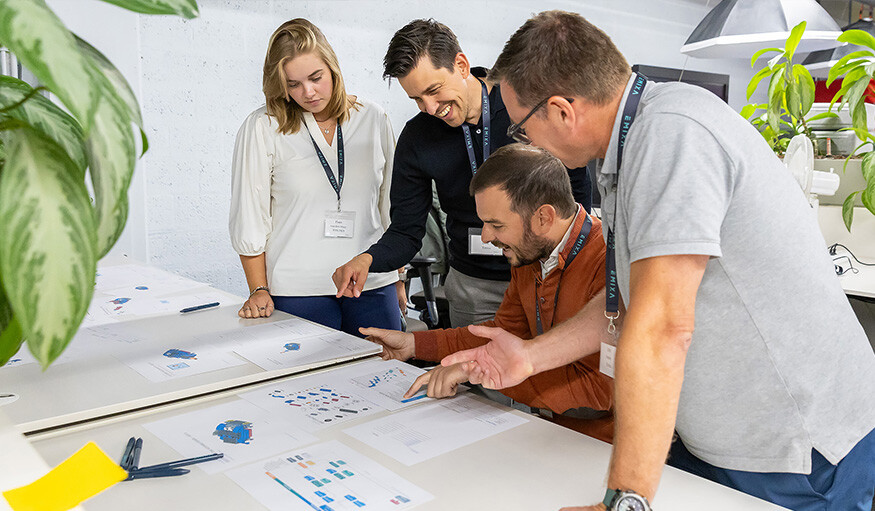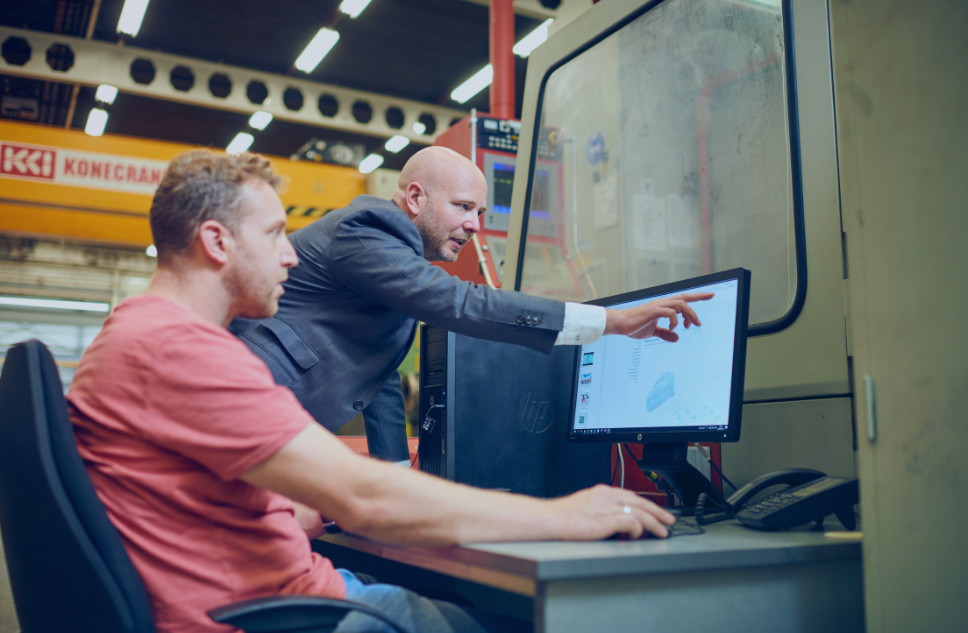News & Blogs
Stay updated with the latest news, insights, and expert blogs from Emixa. Explore industry trends, digital innovations, and company updates all in one place.

- Industry 4.0
- Smart Manufacturing
- +3
Why more manufacturing companies are adopting Smart Manufacturing
Imagine a manufacturing environment that not only does what you say, but also thinks, learns and improves itself. That is Smart Manufacturing: the smart successor to traditional manufacturing, where technology and data work together to make the difference. No more static schedules or endless checks, but real-time insights and automatic decisions that make your processes faster, better and smarter.

- Smart Manufacturing
- Digital Twin
- +1
Digital Twins: The Key to Smarter Manufacturing and Logistics
In today's fast-paced manufacturing and logistics industries, every decision matters. Companies face labour shortages, rising costs, and increasingly complex production processes while striving to optimise resources and maintain a competitive edge. The pressure to innovate is higher than ever.

- Manufacturing
- Digital Twin
The Adoption of Digital Twins in Manufacturing
In the relentless pursuit of operational excellence and superior product quality, the manufacturing industry finds itself at the threshold of a technological revolution. At the forefront of this transformation is the adoption of ‘digital twins’, a concept that promises not only to enhance operational efficiency but also to redefine competitive strategies. This article delves into the emergence of digital twins, tracing their historical roots and exploring their potential to bolster the manufacturing sector's competitiveness.

- Digital Twin
Digital Twin & Thread: From Complexity to Competitive Advantage
The complexity of contemporary product and production processes is increasing explosively. Companies have to deal with customised products, quality, cost reduction, flexibility, sustainability and so on. Complexity is the central theme for all these topics, but how can you turn this complexity into a competitive advantage? Most manufacturing companies know that they need to continuously evaluate and improve the product development process to keep up with the competition. To this end, incremental investments are constantly being made that consciously or unconsciously contribute to a total digital transformation. In previous blogs we have discussed various separate topics in the field of digitisation that are relevant for manufacturers. We have talked about: Breaking down the silos between engineering and production Gaining insight into production processes via simulation models The virtual commissioning of a line or machine The transition from 2D drawings to Model Based Definition Data exchange within the supply chain For all the topics above, they contribute to digitisation within manufacturing. Of course, there are many other important technologies or solutions besides these topics that we will explain in future blogs. This time, our focus is on the overarching theme that ties all these topics together: 'Digital Twins' and the 'Digital Thread.' As we engage with companies about these concepts, we observe a significant increase in manufacturing knowledge over recent years. While only a few years ago, these terms were relatively unfamiliar, it's now apparent that almost everyone has developed their own understanding of them. However, given the varied definitions we frequently encounter, this blog aims to articulate our perspective on these two terms. Digital Twin When we talk about digital twins, we often talk about different variants. For example, you can have a digital twin of your product, but also of your production process. In short, a digital twin for me is the digital counterpart of reality, where all relevant up-to-date information is connected. So when we talk about a digital twin of the product, we don't just mean the 3D CAD file. Although this is of course an important part of the digital twin, that file does not contain all the information. Think of all the requirements and specifications that determine the product, or the performance of the product itself. In our view, a complete digital twin of the product contains simulation models that predict, for example, the rigidity of a product or the air resistance. Of course, the same applies to the digital twin of production. This also includes all the tools, resources, actions, quality controls, programming, etc. required for actual production. Again, simulation models are included that can predict output, guarantee safety and ergonomics on the floor and prevent bottlenecks or collisions with robots and AGVs. The added value of these digital twins includes the fact that everything can be validated and prepared in a virtual environment before a physical product or process is set up. This helps companies bring better products to market faster and at lower cost. Even after the physical products and production processes have been set up, the digital twins offer added value. Most products and processes now contain numerous sensors that collect data on performance. This real-time data can flow back into the digital twins to provide additional insights and implement a process of continuous improvement. However, it is a prerequisite for this that the various applications and departments within companies are well-connected to each other. This brings me to the second term. Digital Thread When we talk about the 'Digital Thread' we mean one integrated stream of data across the different phases of the product development cycle. This means both a connection between the different departments within a company, such as sales, engineering, production and service, but also between the different applications within a company, such as CPQ, PLM, ERP, MES, etc. By connecting all the information, you create a digital thread. This creates traceability in the process. This traceability is becoming increasingly important. Consider the aviation or medical industry, for example. Because traceability ensures that the impact of a change is immediately transparent, and thus prevents mistakes from being made. Does a customer change a requirement halfway through the process? It is then immediately clear which functions and components need to be changed as a result, where they currently are in the process and who is working on them. Thanks to their predictability and traceability, the Digital Twin and Digital Thread can help companies turn increasing complexity into a competitive advantage. Up for a brainstorm? Curious about the other benefits of digital twins and the digital thread? Want to know what digitisation can mean for your business and how we can help you with that? Reach out to us, and we'll gladly provide you with more information.

- Digital Twin
How the CM2 Game teaches the true value of Configuration Management
What is Configuration Management, and why is it so important? How the CM2 Game teaches the true value of Configuration Management

- Digital Twin
The Digital Twin for Industrial Machine Building
The world is going digital. This is not only changing how we work, learn or shop; it is also changing how products are made. Even the smallest machine builder must be able to develop modular, adaptable, multi-functional machines that can be tailored to consumer demand. This requires a high degree of flexibility, which can cause problems for data reuse. The requirements for each machine are then namely customer specific and turn each project into a custom design with a series size of 1. How can machine builders achieve this level of flexibility without increasing costs? In addition, industrial machine builders must show their customers, even before the machine is delivered, how it will work and integrate with other systems. This way, they can demonstrate that their design can achieve the high ROI (Return On Investment) and low TCO (Total Cost of Ownership) that production companies are looking for. They also have to comply with more and more legislation relating to the full life cycle of a machine, from energy consumption to eventual recycling costs. Everything here must be well documented so that it can be demonstrated at all times that the relevant legislation has been complied with. All this costs a lot of time, time that machine builders do not have because they have to compete with competitors from all over the world who are trying to supply the same machines faster and cheaper. Integrated process To cope with this pressure from customers, competitors and legislation, they need integrated tools that prevent working in silos. There is simply no time to design, build and commission a machine in separate consecutive steps by different departments. Such a sequential process is not only slow; you also run the risk here of losing information and introducing errors at any time data goes from one department to another. The designs themselves are becoming increasingly complex. They often have sensors that can monitor the performance and output of the machine and are part of a uniform production system together with other machines. That complexity affects the physical design. You cannot afford to waste time at the end of a project redesigning a component or assembly because the wires and cables cannot be connected correctly. Or when you are testing the physical machine, it is much too late to discover that the control software does not take into account the mechanical limits. Digital Twin With so much software, automation and electronics in modern machines, a mechatronic design platform is needed for a good design that can do much more than just deal with the mechanical CAD design. To solve certain problems, it is necessary to be able to work with multiple disciplines at the same time. The solution lies in new digital technologies that create a digital thread of information between all departments involved in a project and runs through every phase of the product life cycle: from the initial requirements, through design, production, commissioning, delivery and ultimately maintenance of the machine. This form of digitisation allows you to create a digital representation of the smart, connected, custom machine that customers demand: The 'Digital Twin'. This digital twin goes much further than just a 3D CAD design and makes use of the latest technologies and tools for, for example: Electro-mechanical design Topological optimisation Virtual commissioning Simulation Additive Manufacturing Virtual Reality The benefits of digitisation can amount to a substantial increase in production, creating more (and more efficient) machines with the same resources and lowering costs or increasing output at the same cost. See it as a kind of digital productivity bonus. Investing in the next generation of design tools needed to make custom machines is the way to overtake competitors who cannot act as quickly or deliver exactly what customers want, giving you a loyal customer base. Interested in what a digital twin can do for your business? Contact us to find out more about the possibilities.